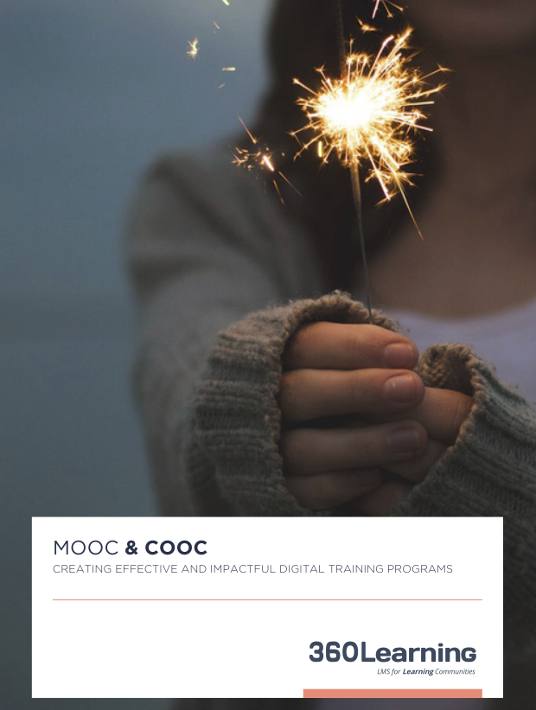Creating A MOOC Or A COOC: Step-By-Step Guide
These 6 steps to creating a MOOC or a COOC can also be applied to the creation any modern eLearning program. By modern eLearning program, we mean courses that focus on collaboration to motivate and engage learners in the course.
Let’s begin.

1. Defining Educational Content
The first step is naturally to design and structure your course content. In a MOOC/COOC, or for any other eLearning content, you must consider and develop your course structure in advance (what chapters or key concepts) and determine what information needs to be delivered when and in what context.
Depending on the type of MOOC/COOC you want to create (internal or external), the content will be different and not necessarily presented in the same way. In an external COOC, for example, the course topic is important but so is the choice of the trainers who will be filmed presenting the course. Not all trainers will accept being filmed, and among those who do accept, not all of them will be at ease in front of a camera. External COOCs will impact your brand image, so make sure to choose telegenic course trainers.
For internal COOCs or traditional eLearning modules, this aspect is much less important. Regarding coursework, on average, a university-level MOOC lasts between 6 and 8 weeks and requires 2 to 3 hours of work per week. An external corporate MOOC is more or less identical. However, for an internal MOOC, the format should be much shorter with 30 minutes to 1 hour of weekly coursework over 2 to 4 weeks. eLearning modules generally last between 15 and 30 minutes.
2. Production
The content production stage is crucial. Once it has been decided what knowledge and skills should be acquired during a course, the information needs to be consolidated and presented using different formats. So, what should you choose?
New online formats have helped MOOCs become successful because of their ability to drive learner engagement: video streaming, hangouts, meetups, Prezi, ThingLink, Wikipedia-style articles, etc. Trainers have an enormous amount of options.
Video is an ideal format. Engagement-wise, it is often better to produce videos yourself, with a simple webcam and then upload them to YouTube or another similar platform. The learner has the impression that the content is up-to-date and this helps create a dynamic learner-trainer environment. It is also possible to create high-quality videos using HD film equipment with multiple cameras, dynamic shots, complex graphics, motion-design, and so on.
If a business is forced to use third parties to produce content (studios or communication agencies), costs will of course increase. At this stage, media coaching can come in handy to ensure that the trainer is comfortable in front of the camera. Videos are certainly important, but so is the rest of the content. Concise Wikipedia-style “cheat sheets” are highly appreciated by learners. The same goes for dynamic content using Prezi or ThingLink. If you want to make your content available to larger audiences, think about having it subtitled as well. At 360Learning, you have the freedom to choose: either we advise you on creating course content and you produce it internally or you can benefit from our large partner network; specialists in creating educational content, who can produce high-quality content for you.
3. Technical Integration
The technical integration phase, the last phase before launching a MOOC/COOC consists of formatting course content on the platform. Some tools are complex and require advanced computer or web development skills (Open-EDx or Canvas, for example).
In this case, it is highly recommended to have a competent computer specialist to help with this step. Some tools integrate (and invoice) this step automatically as part of their sales process. Other platforms, including 360Learning, have simplified this phase as much as possible so that trainers do not need any technical skills and are able to integrate course content themselves.
At this point, it is always recommended to use beta testers to ensure that everything is working properly prior to the official launch of the MOOC/COOC. It is not uncommon for a course document or other essential element to be forgotten…
4. Communication
Developing a communication strategy is fundamental when producing a MOOC/COOC. Before launching, you should announce that registration is open, produce a teaser video, and regularly post on social networks while simultaneously working on PR campaigns. Your communication strategy should generate interest and increase the number of registrations for the different MOOCs/COOCs.
During the course, the communication strategy is aimed at decreasing learner drop-out rate and highlighting key moments in the course (meetups, hangouts, guest speakers). After a course is completed, you should communicate on course success stories, talk about new initiatives, provide learner testimonials, and publish course statistics, using for example an infographic. This “reporting” phase is fundamental and can often lead to additional press coverage. A large team is not necessary to carry out all of these actions as long as you are organized.
You should develop a communication plan that starts 4 months before the MOOC launch date and runs 2 months after the course end date. Press releases should also be drafted; course trainers and project managers should make themselves available to talk to the media. Do not forget to establish a Community Management strategy on social networks as well because it can also help increase the number of enrollees.
Any eLearning action, whether internal or external, needs a communication plan. This aspect that is all too often neglected, helps reinforce project engagement and commitment.
5. Course Animation
The course animation phase of a MOOC/COOC is a means of engaging learners and providing them with a positive and exciting training experience. The attention given to MOOC/ COOC enrollees by a training organization will play a significant role in how the company is perceived in the eyes of learners.
When a course starts, you must manage platform interactions but you should also monitor interactions that take place on social networks including Facebook and Twitter. Remember that animating a COOC/MOOC also includes off-line actions. To show that an organization is truly engaged in training, it is highly encouraged that the organization, or the trainers themselves, organize meetups. The same goes for video conferences, highly appreciated by learners.
For any digital training program, managing the learning community is the key to driving engagement with course content. Once again, certain platforms do not offer this collaborative option. They risk alienating users who have adopted these new digital practices.
6. Course Overview
Once the course is over, results should be reviewed and analyzed. Relying on performance indicators established before the start of a training program, you can determine whether or not the project was successful, understand what did not work and improve those aspects for future projects.
These indicators will, of course, take into account the number of enrollees, the no-show rate (enrolled but never participated), course completion rate, number of certificates awarded, platform interaction quality and so on. It is up to each individual organization to determine the criteria for success for their MOOC/COOC.
Sometimes forgotten, these KPI (Key Performance Indicators) are an essential element for making decisions. They help project managers prove how valuable their courses and training programs are internally, how important it is to continue with the project and receive additional resources.
If you want to learn more about creating a MOOC or a COOC, download the eBook MOOC & COOC - Creating Effective And Impactful Digital Training Programs.









